Part 1 A short history of the spring-piston power plant
Part 2 A short history of the CO2 airgun
This report covers:
- It all started…
- What is a precharged pneumatic gun?
- Butt flask
- Girardoni
- Ball flask
- Air canes
- The gap
- BB’s rant
- Where are PCPs going?
- Summary
Today we look at the history of the precharged pneumatic (PCP) airgun. This is the oldest and most convoluted of all the airgun powerplants. When it comes to pneumatics we have to separate them into PCP, multi-pump and single stroke because each has a unique history and they all started at different times. The PCP is the oldest of all. We believe it dates back to the mid-16th century, but the oldest intact airgun action is dated in the very early 1600s, so that would be the beginning of the 17th century. I will therefore be bringing you histories of the multi-pumps and single strokes separately.
It all started…
… centuries earlier with the blowgun. The blowgun was/is powered by human lungs and qualifies as a pneumatic, since the air is first taken into the lungs and then expelled by means of the diaphragm forcing the air out rapidly. Considering that is the blowgun a PCP, or is it instead a spring-piston gun? That’s a debate that has raged for years, and no doubt you readers will wish to join in.
What is a precharged pneumatic gun?
A pre-charged pneumatic gun is one that is first charged with air under pressure, which it holds until released on command by means of a valve. By that definition the blowgun doesn’t seem to be a PCP. It’s more like the early dart guns that had bellows that closed rapidly to force the dart out the barrel on command. There are no valves involved with the primitive bellows gun. But the PCP had a valve to hold and release the air on command. The command came by means of a trigger.
Butt flask
The early PCPs usually contained their pressurized air inside a hollow butt. They are collectively called butt flask guns unless there is a good reason to distinguish them. The butt is made by folding iron plate into a conical shape with a long seam where the metal joins. The place where the metal joins is folded to make a mechanical joint that is then soldered for an air-tight seal. The end of the butt is similarly attached to the rest of the hollow structure by the same mechanical means and then soldered as well. It sounds easy when explained, but it took a lot of careful craftsmanship to ensure all the seams were air tight. The small end of the butt is reinforced to allow a valve to be attached. That’s the point where the butt screws onto the receiver.
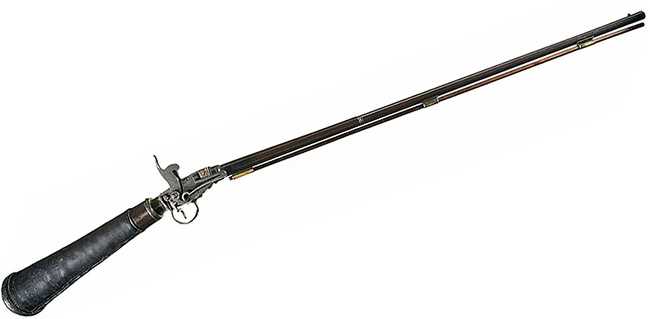
Early butt flask airgun.
Girardoni
The most famous butt flask airgun was a repeating rifle called a Girardoni, after Bartolomeo Girardoni, the man who designed it for the Austrian army. It is a 21-shot ball-shooter with a gravity-fed magazine on the right side of the rifle. This is the air rifle carried by Lewis and Clark on their famous expedition to explore the central and western territory of what became the United States.

A Girardoni of 1780.
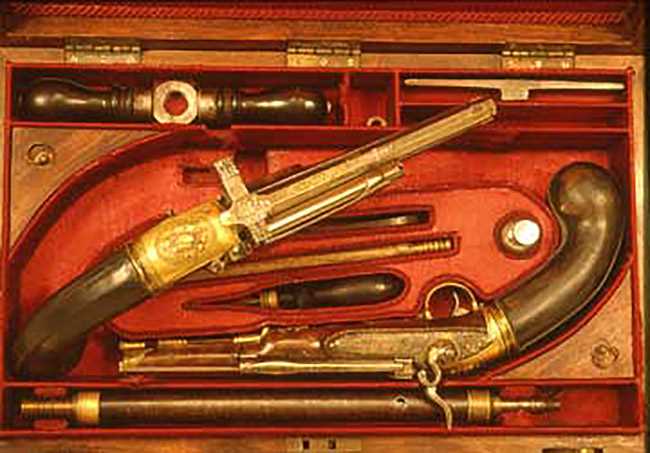
Cased Cantarini air pistols. The air is stored in the butt of each pistol. These repeating air pistols were made on the Girardoni principal.
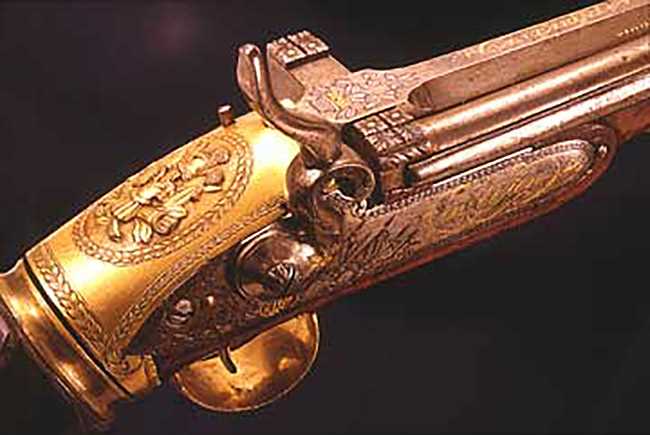
The details on these pistols make it obvious they were made for either royalty or nobility.
Ball flask
I say that many of the early precharged airguns were butt flasks, but not all. The ball flask is recognized by a ball-like air reservoir and is considered an icon of early airguns. And I have seen other early airguns that have hollow shrouds around their barrels to contain the air. They are very complex and are extremely rare. One that was made like that was actually a very early multi-pump whose butt plate was stepped on while the entire gun was pumped up and down! But I digress.
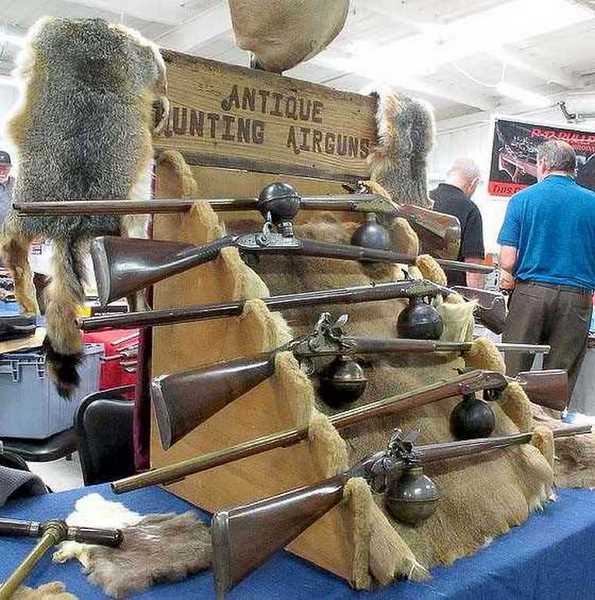
Here are a few ball flask long guns. Larry Hannusch’s display at the 2014 Ft. Worth Airgun Show.
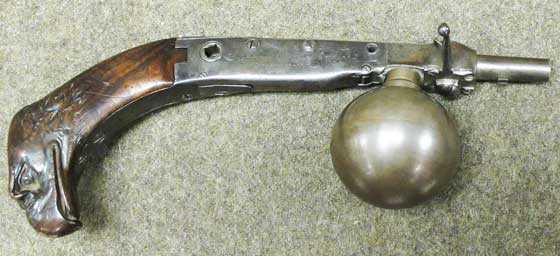
Ball flask rifles are rare but when was the last time you saw a pistol?
Well, PCPs continued to evolve, but since they were handmade, there was no competition and very little recognition. So their evolution went slower throughout the 19th century. But one interesting offshoot was the air cane.
Air canes
We covered air canes recently. Though some people say they were used for self defense, they are really too cumbersome and problematic for that. They are simply an interesting niche of precharged pneumatic airguns that existed from the 19th century until about 1920. They were all made by hand, by cottage makers who turned out parts and assemblies that larger firms purchased and used in their final products. After World War I the skills to make them went away, as the demand evaporated. In the final years the few canes that sold were assembled from parts remaining after the war.
The gap
Following the 1920s there wasn’t any real activity in precharged guns until 1980, when Daystate turned a game capture dart gun into a .22-caliber pellet rifle they called the Huntsman. That was when the modern era of precharged pneumatics started.
BB’s rant
I wrote a newsletter called The Airgun Letter from 1994 until 2002 and in 1996 I bought a used Daystate Huntsman so I could review it. It was my first precharged airgun. The Brits who made the thing were absolutely cliquish about sharing information. Such things as how to fill your airgun were considered state secrets until you obtained their official decoder ring.
And the prices? Get outta here! That, more than anything else, was the reason I took the idea of what became the Benjamin Discovery to Crosman in 2006. I wanted everyone to know about these airguns and how to properly operate them. The rest is history and it’s history that most of you readers know because you have lived through it or at least read about it.
The Benjamin Marauder blew the competition away and the airgunning world had to acknowledge once more (since the half-millennium that ended in 1920) that the PCP was a good thing. Prices fell and quality went up. That was mostly because of the internet, where shenanigans can’t survive very long. You can beat up a Chinese manufacturer on price only so far. If your airgun has to hold air, that’s the end of it.
And now with this blog we are demanding good triggers, accurate barrels and stuff like .457 bullets instead of .452 bullets — if our big bore barrel needs them. Knowledge is power!
Okay, off my soapbox.
Where are PCPs going?
I usually don’t do predictions like this but this topic is too ripe for it. We need:
- PCPs that are slim and trim, but not short.
- Balanced valves or reliable regulators.
- Fill levels of 3000 psi or less.
- Accurate barrels.
- Great triggers with some adjustability — but not the world.
I don’t know of a PCP that has all of that today. But it’s all possible. You see, many airgun designers are satisfied when they get the gun to work at all. If they achieve what their marketing department says is the Holy Grail of 1,000 f.p.s. (.177) and 30 shots, they’re done. But why stop there? Why not build a platform with all these features? Don’t do it all at once. Take a current winner and look at what still needs to be done. Then do it in increments. Do that and release a model that no one can compete with.
Summary
PCPs have been with us for over 500 years. Where should they go next? How should they get there?

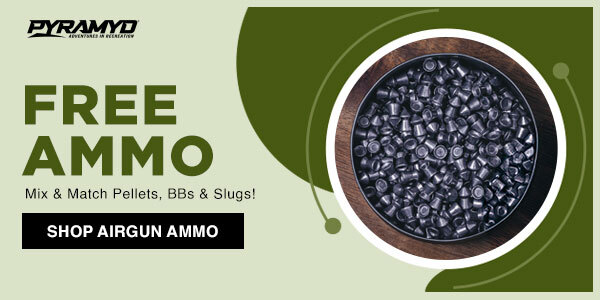
B.B.
What kind of pressures where inside these guns?
-Y
Yogi
Around 500 psi I think. Maybe it was less.
Yogi,
Low pressure. 600 to 800 psi.
BB
B.B.,
The ability to convert so little compressed energy into serious foot-pounds is the trick, isn’t it? As Dennish Quackenbush, Tim McMurray and Gary Barnes have shown, slowing the lock can improve the power of an air gun with relatively low air pressure.
Unfortunately fast lock times promote accuracy but slower locks allow things to get messy downrange.
Michael
BB,
So the bellows gun is considered as an evolutionary dead end as far as airguns were concerned.
Siraniko
PS: Figure 3 caption last sentence “These repeating air pistols were made on the Girardoni principal (principle).
Siraniko,
Fixed it. Thanks,
BB
B.B. and Siraniko,
The bellows gun was essentially an early multi-pump pneumatic, wasn’t it?
Michael
Michael,
No. it was a type of spring gun in which a bellows did the work of a piston.
BB
Huh. I had no idea.
I remember seeing an air rifle for sale that used an electric motor to compress it’s spring. Many airsoft guns operate electrically. There are optics that can share the view with a computer…
… I would not be surprised to see yet more electronics, including microchips and connectivity to the internet, incorporated into airguns in the future.
Personally, I would settle for a reliable, self contained and fit for purpose pre-charged pneumatic repeater. Note, I mentioned ‘reliable’ first. 🙂
hihihi,
They have had electronically controlled valves that can be programmed for years now. They are very nice, but I keep thinking of Murphy. That is more stuff to go wrong.
What you want, exists. You must decide on its purpose first.
RidgeRunner, I did not know about programmable valves.
To confirm, the most important aspect for my ideal pcp is that it should work flawlessly and reliably! So yes, another FX Independence or Seneca Aspen but with better onboard pumps would suit me.
I would add that the power can be a deal breaker, ie for many airgunners in the world it has to be below their country’s limit! Maybe that’s where those fancy valves could help. 🙂
Daystate is famous for them. With such a valve you do not need a regulator. Also, like you said, the air rifle can be programmed pretty low, but it can also be programmed pretty high. The idea is to produce shot consistency at whatever level it is programmed to.
At one time I gave the Independence very serious consideration but was not impressed with the price when I looked at one closely. I have not looked at the Aspen up close, but it looks pretty bulky. I think I would rather carry my Maximus. It is pretty light and has enough air for about 25 shots. If I cannot get my limit with that, I had better go home anyway.
How can a PCP be self-contained? Oxymoron.
-Y
Yogi
I believe he is talking about something like the Seneca Aspen. Basically a PCP with a pump as a part of the rifle. Or the Nova Freedom. There may be others. Multi pumps and single strokes are PCPs by definition, too. They are just single shot guns.
There are, right now,, all the airguns we would ever need. As BB said,, they only need to be improved slightly to accommodate everyone. Perhaps a feature that should be added to the wish list is complete modularity (which we were promised but have yet to see) so that we could customize them ourselves,, not unlike the AR platform of PBs.
Ed
edlee, I could not have explained myself better, thanks.
Sorry Yogi, I should have expressed myself more clearly.
BB,
I would really like that first butt flask airgun. Of course, I would not turn my nose up at a Girardoni or a ball flask air rifle either.
The Discovery/Maximus/Fortitude platform would be an excellent choice to work from for the “ideal” PCP of which you speak. My Maximus will very likely end up with the longest Lothar Walther barrel I can get. Huma also makes a very nice regulator for it. There are an incredible number of parts and accessories for this platform. Crosman could put together a real nice PCP that would not break the bank.
RR
Yep about the Maximus and Discovery.
And if you ever do get that long Lothar Walther barrel on your Maximus let me know. I will buy the Maximus barrel if you want to sale it or something down the road.
LOL! That is not likely going to happen. I am seriously considering cutting down the air reservoir to the end of the stock. If I find that round tuit, I will want a shortened barrel to go with it. It would make a dandy little carbine. That will likely happen first.
The long LW will be for long range shooting. I may just build another air rifle for that. I think that little carbine with that small Hawke on top will be a dandy little popper, especially if I drop that Huma reg in there.
RR
Sounds like a good plan to me. I bet you will like them.
I think it will make me very happy, at least on the Dark Side.
RR
Yep I believe so.
BB,
I think a lot of where the future of PCPs will go can be found in the Huben K1. I know that PA does not sell them, and that they are an expensive gun, but they have so much new stuff going on that is amazing. Of course it all starts with the hammerless valve system, which uses two valves to control operation – the main “firing” valve and the second “closing” valve, with the closing valve being easily adjustable via a power wheel. I have my .22 Huben set to normally shoot JSB 18.1s right at 900 fps, but can reapeatably dial it down to shoot 14 grain pellets at 500 fps or dial it up to shoot 25.4 Monsterls at 900 too. I once alternated pellets in the mag and adjusted the power wheel for each shot, and each shot was within the normal ES once would expect for its respective tune. Simply amazing.
While it is rated at up to a 5000 psi fill (compliments of a titanium reservoir), it is regulated and thus does not need to be filled anywhere near that high – but I can vouch that it works well (with lots of shots) when filled to 4500 psi. And it can work fine on a 3000 psi fill (with fewer shots). And the regulator is great – it can be externally adjusted up or down without degassing the gun, and it can even be vented completely allowing one to remove and work on the action, all while keeping the main tube pressurized – leaving air on board to keep shooting afterwards (if enough air is in the reservoir). It is kind of different having a gun that can take as much air pressure as you can give it, since I have no way of filling to 5000 psi – I just connect the tank and fill it as high as I can with no worries.
Of course it is a semi-auto too, and has a really impressive trigger – at least for a bullpup semi auto. The trigger is not as nice as my Marauder or Daystate guns, but it is still very good. And it does not “waste” air to make the semi-auto function work – it is driven by internal pistons that drive the magazine as the “firing” pressure builds back up after the “closing” valve shuts. And it is very fast – in “spray and pray” mode on the trigger, all 19 shots in the mag can be sent down range in under 5 seconds.
The drawbacks are that the 19 shot mag is not removable, and there is no good way around this as the gun is designed – it shoots the ammo from the magazine, so extreme precision is important. This also leads to a barrel that is difficult to clean – doing it well involves some careful disassembly of the gun. And of course the gun is always live when charged; take the saftey off, pull the trigger, and it will fire – if there is ammo in the mag it is sent out the barrel. There is no way to “uncock” the rifle to make it so that nothing happens when the trigger is pulled, other than to insure the mag is empty and no way to easily visually indicate the gun is empty either (but it is easy to check to see that the mag is empty by unlocking it and fully rotating it to visually inspect each it). That said, I have the same level of faith in this gun as I do for any of my others when cocked and on safe – I just treat it accordingly. I am used to putting it away in the safe loaded and on safe, just as my others sit in the safe with ammo in the magazine but uncocked (and thus with no pellet in the barrel).
There is a lot of very new tech in this platform. As the new tech in this platform matures, and people invent ways to make them less expensive and more serviceable, I think they will come to be very common. There is a lot of info online about this gun, and a similar one by LCS (the LCS does not have as good a trigger, but adds full auto function too). Both use the hammerless system.
Alan,
Like that the K1 has a 5,000 psi rating, great for safety and shot count reasons!
I believe that PCPs should be made to safely handle at least a 4,500 psi fill giving the owner the opportunity to fill to what ever his setup allows.
Hank
Alan
I have thought about getting a LCS. And I think the mag is not removable on it. That’s not good if you get a pellet jam. And semi auto guns do that at times. Plus the LCS are pretty exspensive guns.
Now if I could rent a LCS for a week or 2 and send it back after that I would like that. 🙂
Gunfun,
In truth, when I first got permission from my wife to spend the funds on one of these, I was heading down the LCS path too. But after much research, including discussions with people that had both, I ended up picking the Huben and I have been very happy with it (but in fairness I have not shot the LCS). The biggest factors in favor of the Huben is that the trigger is way better, and it carries and shoulders better too. The only real advantages of the LCS is that it adds full auto (at the cost of a poor trigger in single shot mode – part of the design compromise, in that it works better in full auto mode than single shot mode), and it is easier to remove the barrel if needed – but it still has to be removed for any cleaning or clearing a jammed pellet.. Also, for the LCS both .22 and .25 cal have 19 shots (with a non-removable magazine), but the Huben holds 19 in .22 and 17 in .25, so that is a factor if you prefer it in .25 cal. As for cleaning or clearing jams, once you learn the Huben it is easy to work on – I can take mine down to clean the barrel in under 5 minutes, and have it back firing in a few more (but a few test shots over the Chrony are going to be needed to get things back to where you want them).
I love your idea of renting an LCS for a test run – I would do that if only to “scratch the itch” and move on. I will say that when I first got the Huben I shot so many more pellets than before – I easily put 10K rounds through it in six months. But it has now settled into a more normal shooter for me that just happens to be a semi-auto. It is my go-to gun, but I no longer empty the mag any time I am shooting, as I used to do when I first got it. It is nice to never have to cock the gun, and thus reposition hands or head between shots, but that does not mean that one must shoot more in the end . . . but I’ll say that the grin factor of popping off double taps (or more) is really high!
Alan
Alan
Yes the Semi-auto guns will make you want to rapid fire. To me that’s not a bad thing though. It’s nice to have that type of fun factor available when you want it. 🙂
Appreciate that the Daystate Huntsman is mentioned in B.B.’s short history of the pcp since it was his first pcp acquistion.
B.B. also owned a USFT. This also deserves to be mentioned since the USFT fills to around 1200-1500 psi, comes unregulated or regulated, has infamous low ES and high shot count, wonderful trigger, is a very simple design with few moving parts so it’s easy to work on and highly adjustable/customizable for a new configuration that can be done in minutes to fit your shooting needs and wants. I think the USFT is revolutionary and underappreciated. Tim and Larry are true airgun geniuses in my book.
Kevin,
I have to agree with that. Both men are airgun geniuses!
BB
BB
I would say Lloyd Sikes should be included too. He’s done some interesting stuff with air guns.
Kevin,
Totally agree on your reply on the Huntsman and especially Tim McMurray and Larry Durham for the USFT. I think we need to also add Dennis A. Quackenbush’s work on gas guns and PCP’s to any early Modern era history..
shootski
BB,
When you mentioned “slim and trim” my mind goes to the FX Tarantula. I think the Tarantula with the imported walnut stock is the best looking airgun I can think of. I sure agree with you on the 3000 psi or less fill.
David Enoch
David,
I would also include the Cyclone.
It’s a beaut! From what FM read about it, shoots beautifully as well.
B.B,
Great writeup of PCPs!
“The blowgun was/is powered by human lungs and qualifies as a pneumatic, since the air is first taken into the lungs and then expelled by means of the diaphragm forcing the air out rapidly. Considering that is the blowgun a PCP, or is it instead a spring-piston gun? That’s a debate that has raged for years, and no doubt you readers will wish to join in.”
The debate is still going on since the folks debating don’t know their respiratory physiology!
The diaphragm is powered by muscles to breath in. The breathing out is caused by the internal lung pressure being higher initially and at some point the outside air pressure differential becoming higher and pushes the remainder of the air out of the lungs.
So both the bellows and Precharged theories are correct; but each is only half right!
I learned all that during pressure breathing training at Naval Aviation Training Command.
shootski
Shootski,
So, (to stir the pot 🙂 )… the muscles that move the diaphragm could be considered to be “organic springs”, the diaphragm a piston and the lungs as the air chamber/tube which, by description, makes a blowgun a single shot, break action springer. Right? 😉
Hank
I would argue that the blow gun was a bellows powered airguns. Lungs are the bellows and are filled and compressed manually. Shootski is right, it seems to me for normal breathing, but when exhaling with force, like blowing up a balloon or blowing a blow gun, other muscles including the diaphragm are used. Spring guns gas or coil are not a good analogy because it is not just the potential energy of the breath you take in that powers the blow gun. Neither is the pcp, because it is not the air pressure held in the lungs that powers the dart. It is the power of the muscles compressing the lungs and making the pressure higher than the resistance of the dart in the blow gun, like a bellows.
Good argument Roamin!
Agreed, The diaphragm does operate the lungs pretty much as bellows during normal breathing. (Was hoping that shootski would rise to the bait and comment 🙂 )
Hmmmm… guess that the throat/mouth could be called an “adjustable transfer port” eh?
H
BB
I am missing something. How can any serious thought be given to a blowgun being a spring piston? Springers have a piston which moves forward compressing air to move the projectile through the barrel. Blowguns have no piston.
Fine blog today but help please.
Deck
Decksniper,
I think BB is referring more to the bellows gun. Since the rear stock which contains the bellows is compressed by a spring to compress the air to blow out the dart. Maybe Tom can chime in since I think he meant the bellows gun instead of blow gun.
Siraniko
Deck,
The spring is your diaphragm. The air in your lungs is not under pressure.
BB
BB
And no piston.
Deck
It is both PCP and gas ram. Despite the lungs being enlarged, there is a tad bit pressure build up, and also, the diaphragm is acting like the piston and pushing the air out. If we blew the blowgun like the opera singers singing, simply using our throat like the valve and letting the air flow, then yeah, some sort of PCP with an enlarging tank could be imagined – But the diaphragm does most of the job pushing the air out when we blew into the blow gun. I think a blowgun is an all-different breed of its own.
Fish,
See the link to what nurses learn down below!
No blowing smoke rings!
shootski
BB,
I liked the report today. I believe PA should add a new line of quality blowguns. Blowguns are the only type of air guns that PA doesn’t sell.
By the way, where is our friend who destroyed the plastic bottles with spaghetti darts? He took your custom air rifle home and disappeared. I think his opinion on the subject of blowguns matters.
How about a brief report on the history of blowguns? I think your blog can put an end to the blowgun categorizing discussion and create a new category for the lung / diaphragm powered guns.
Fish
I remember that. He shot spaghetti right through that aluminum can with a piece of pvc tubing, and a piece of spaghetti skewered through a marshmallow. Genius.
Deck,
Please see my blowgun/springer analogy in my comment to shootski (above).
Hank
Agreed.
I think there’s definitely a market for reproductions of these old guns.
I’m still amazed that there aren’t any older percussion/flintlock type co2 replicas either
Ade C, a reproduction Girardoni? Oh yess please! 🙂
Searching online for “airsoft flintlock” returned some examples, but they look like toys to me. Better get the real deal, ie black powder propelled, lead ball firing replicas. Happily where I am the law lets me… 🙂
Yes, at least those are still allowed here in the UK. For now at least. I’ll be shooting my Dad’s .577 Snider Enfield this weekend. Can’t wait!
For crusty FM, seems the Maximus line checks off a lot of boxes in terms of PCP simplicity, ease of use and just plain shooting enjoyment. Now if manufacturers can only learn to stick with a winning product and go for the incremental, qualitative improvements, instead of bringing out a new half-baked blingy thing every year or two, the future of PCPs looks promising.
I had a right handed Cyclone. It was nice but being a lefty, I eventually sold it. I missed it and found a Webley Spectre which is a FX Cyclone in a Webley ambidextrous stock. I bought the Spectre and really like it. I like the FX 3 position power lever better than any other adjustable power ideas I have seen.
David Enoch
BB,
Interesting blog – that’s really impressive work on those old guns!
IMHO, think that the term “blowgun” is a bit of a misnomer and that “coughgun” might be more appropriate.
As a youngster I had a chance to try an authentic blowgun (think it was from Malaysia or somewhere in that area) that was part of my friends father’s collection of aboriginal weapons that he amassed while serving in the British army.
The blowgun was about 7 1/2 feet long (didn’t touch the ceiling but too tall to go through a door without angling it) and the darts were about a foot long.
All in all it was an impressive weapon. Unfortunately blowguns are classed as “prohibited weapons” (same as machine guns) here in Canada, think that they would be ideal for backyard pesting.
Hank
Hank,
Isn’t it just the Curare that’s prohibited? ;^)
Michael
Micheal,
The most scary thing about that blowgun experience was that the darts WERE POISONED!
My friend shot at a cat using the garden as a toilet thinking to give it a poke in the butt. The cat jumped, ran 10 feet, did a couple of circles and expired!
We were not allowed to go into his father’s den (which made it more tempting of course) but we never touched any of the blowgun darts again!
Hank
B.B. and Readership,
Listen up and get it straight PEOPLE! This is straight from the NURSES:
https://www.nursingtimes.net/clinical-archive/respiratory-clinical-archive/the-respiratory-system-part-4-breathing-13-06-2006/
The normal inhalation is ACTIVE and a normal EXHALE is PASSIVE!
If you don’t believe me read the link or come fly with me above 10,000′ and I will have you pressure breathing with an O2 mask; it is quite an experience especially above 30,000′ when the mask valve is not functioning 100% on the EXHALE!
I really liked the cute blond contract nurse that took care of me last time I was in Walter Reed ;^)
shootski
Yeah, when you nonchalantly breathe. When I blow into a blowgun though, I know I use my diaphragm.
Yes Fish!
If you had read the nurse’s lesson you would have learned what muscles are actually used for good blow gun technique! Now you will just remain an average Blowist; you could have been one of the Great ones if you worked the correct muscles.
So one last chance to reach for the Brass Ring:
“In forced expiration, when it is necessary to empty the lungs of more air than normal, the abdominal muscles contract and force the diaphragm upwards and contraction of the internal intercostal muscles actively pulls the ribs downwards. This generates higher air pressures within the lungs and forces the air out more rapidly.”
So what will it be Fish? The choice is yours….
shootski
‘The contraction of the internal intercostal muscles actively pulls the ribs downward’ and act like a piston, which makes the blowgun both PCP and springer to an extent – that was my point. Yeah, if anything helps me blow at a faster FPS, I sure will prefer it. Maybe what you are telling is what I casually do anyhow, and I might have just called it diaphragm push. But if you’re claiming that a blowgun works with the same principle as a PCP, then we still have disagreements.
Fish,
On my very first post about this i wrote: “So both the bellows and Precharged theories are correct; but each is only half right!” So I really don’t see any disagreement…those other folks, to include B.B., are just wrong…LOL.
shootski
“Both the bellows and pre-charged theories are correct; but each is only half right!”
This…
I think we agree. 🙂
shootski,
In my case the forced exhalation always produces hot air!
Michael
Michael,
I almost threw up my hands and went on to something else because it is taking two or more Log On attemps to REPLY…AGAIN!
BUT, I percevierd and Logged On multiple times to make certain that hot air you say you are exhaling isn’t because you’re Vaping!
If it is Vaping related you just need to stop that.
It will effect your shooting accuracy.
Be Well!
shootski
shootski,
No vaping.
Michael